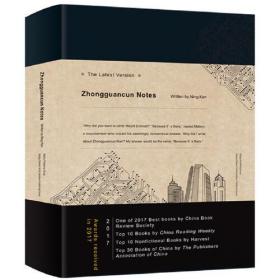
中关村笔记:英文
批量上传,套装书可能不全,下单前咨询在线客服! 正版书 !!!
¥ 17.43 3.2折 ¥ 55 全新
库存9件
作者宁肯 著 , 新经典 出品
出版社北京十月文艺出版社
ISBN9787530220184
出版时间2019-12
装帧平装
开本32开
定价55元
货号28540438
上书时间2024-10-19
- 最新上架
商品详情
- 品相描述:全新
- 商品描述
-
导语摘要
《中关村笔记:英文》将视野聚焦于中国改革开放缩影的北京中关村地区。中关村科技园,源于20世纪80年代初北京的“中关村电子一条街”,是中国高新技术产业开发区,国家自主创新示范区,人才特区,是中国体制机制创新的试验田,也被誉为“中国的硅谷”。中关村在很大程度上改变了北京,也改变了中国,《中关村笔记:英文》以冯康、陈春先、柳传志、王选、王洪德、冯军、王志东、吴甘沙、程维等十几个代表人物为经纬,书写了中关村几十年里的风云激荡。《中关村笔记:英文》会在英语世界彰显我们大国崛起的风范,彰显知识分子忠贞报国的情怀,必将为我国的对外宣传增添浓墨重彩的一笔。
作者简介宁肯,1959年生于北京。现已出版长篇小说《蒙面之城》《沉默之门》《环形山》《天·藏》《三个三重奏》。另有中短篇小说集《词与物》《维格拉姆》,散文集《说吧,西藏》《思想的烟斗》。获第二届、第四届老舍文学奖长篇小说奖、首届施耐庵文学奖,第四届《人民文学》长篇小说双年奖,第七届北京文学艺术奖,首届香港“红楼梦奖”推荐奖,《当代》2001年文学拉力赛头名,第八届茅盾文学奖提名,首届美国纽曼文学奖提名。散文集《北京:城与年》获得第七届鲁迅文学奖。
目录Contents
AnIntroduction1
FengKang’sStory(1)4
Note1:SilentCornerstone16
TheFirstPerson18
Note2:Coincidence32
ThePulloftheFuture33
Note3:Time51
TiltingatWindmills52
Note4:Volcano58
China’sLenovo(1)60
Note5:History75
FengKang’sStory(2)77
Note6:FengKangSchool91
MS-240192
Note7:AnotherTypeofKnowledgeTransmittedfromFathertoSon104
AMillenniumCovenant106
Note8:InstallationafteraMillennium141
China’sLenovo(II)143
Note9:ShadowsofEverything157
Wang’sCode159
Note10:SpiritofChineseCharacters164
FengFive-yuan166
Note11:TheGrassrootsSpirit171
FengKang’sStory(3)173
Note12:ABronzeStatuethatStandsForever188
LegendofLenovo(3)190
Note13:MountTai206
KV300207
Note14:DiseaseandCreation212
Internet214
Note15:TracesofDaysGoneBy222
LegendofLenovo(4)226
Note16:“GatheringMomentum”233
“Fingerprints”235
Note17:TheNewGeneration241
GarageCafé243
Note18:Zhongguancun,Beijing260
SharingforaBetterWorld262
Note19:Ongoingentrepreneurshipandinnovation290
Postscript293
Appendix294
内容摘要《中关村笔记:英文》将视野聚焦于中国改革开放缩影的北京中关村地区。中关村科技园,源于20世纪80年代初北京的“中关村电子一条街”,是中国高新技术产业开发区,国家自主创新示范区,人才特区,是中国体制机制创新的试验田,也被誉为“中国的硅谷”。中关村在很大程度上改变了北京,也改变了中国,《中关村笔记:英文》以冯康、陈春先、柳传志、王选、王洪德、冯军、王志东、吴甘沙、程维等十几个代表人物为经纬,书写了中关村几十年里的风云激荡。《中关村笔记:英文》会在英语世界彰显我们大国崛起的风范,彰显知识分子忠贞报国的情怀,必将为我国的对外宣传增添浓墨重彩的一笔。
主编推荐宁肯,1959年生于北京。现已出版长篇小说《蒙面之城》《沉默之门》《环形山》《天·藏》《三个三重奏》。另有中短篇小说集《词与物》《维格拉姆》,散文集《说吧,西藏》《思想的烟斗》。获第二届、第四届老舍文学奖长篇小说奖、首届施耐庵文学奖,第四届《人民文学》长篇小说双年奖,第七届北京文学艺术奖,首届香港“红楼梦奖”推荐奖,《当代》2001年文学拉力赛头名,第八届茅盾文学奖提名,首届美国纽曼文学奖提名。散文集《北京:城与年》获得第七届鲁迅文学奖。
精彩内容Index of Important Figures
Feng Kang (1920-1993), mathematician, member of the Chinese Academy of Sciences and pioneer in the study of Chinese modern computational mathematics. He independently created the finite element and natural reduction and natural boundary element methods. He opened up the new study field of symplectic geometry, made a significant contribution to the formation and cultivation of talented people in the field of computational mathematics in China, and enjoyed renown as a world-level mathematician. Fields Medal winner and foreign academician of the Chinese Academy of Sciences Professor Shing-Tung Yau said in his lecture “My Opinions on the Development of Chinese Mathematics” at Tsinghua University: “For China to surpass or be neck and neck with the leaders in modern mathematics, there are three main reasons: one is Professor Shiing-Shen Chern’s demonstration work, another is Hua Loo-Keng’s contribution to the function of several complex variables, and the third is Feng Kang’s contribution to finite element calculations.”
Feng Kang’s ancestral home was in Shaoxing, Zhejiang Province. He was born in Wuxi in 1920, and spent his childhood and teenage years in Suzhou, Jiangsu Province. In 1939 he was admitted to the Department of Electrical Engineering, National Central University, majoring in physics and mathematics. In 1945 he served as a teaching assistant in the Department of Mathematical Physics at Fudan University in Shanghai. In 1946 he taught at Tsinghua University. From 1951 to 1953 he studied at the Steklov Mathematical Institute in the Soviet Union, under leading Soviet mathematician Pontryagin. In 1954 he published his “Generalized Function Theory” and established the generalized Merlin transformation theory at the suggestion of Professor Hua Loo-Keng. In the late 1950s and the 1960s Feng Kang led a team to discover a successful course for China’s computational mathematics from practice to theory and then from theory to practice. In 1965 Feng Kang published “Difference Scheme Based on the Variational Principle” in Applied Mathematics and Computational Mathematics, which marked China’s independent foundation of the finite element method. He served as director and research fellow of the Computing Center of the Chinese Academy of Sciences from 1978 to 1987, and as an academician of the Chinese Academy of Sciences from 1980 to 1993. He was the president of the China Society for Computational Mathematics from 1985 to 1990. Feng Kang passed away in Beijing in 1993.
Chen Chunxian (1934-2004), born in Chengdu, Sichuan Province, was a leading nuclear physicist. He studied in the Soviet Union from 1952 to 1958. From 1959 to 1966 he engaged in research and development of theoretical physics, laser semiconductors and other new areas at the Institute of Physics, Chinese Academy of Science. From 1970 to 1986 he initiated domestic fusion research, and established the first Tokamak device (No. 6) at the Institute of Physics, Chinese Academy of Sciences. Later, he built the fusion base of the Chinese Academy of Sciences in Hefei. The scale and level of the base are still the highest in China. In 1978, after the “cultural revolution,” Cheng Chunxian was among the first group promoted to researcher fellow (professor level). Chen Jingrun was in the same group. Chen Chunxian attended the first National Science and Technology Conference. He was also one of the first batch of doctoral supervisors approved by the National Academic Degrees Committee. During his three visits to the United States from 1978 to 1981, he proposed to establish “China’s Silicon Valley” in Zhongguancun and set up the “Advanced Technology Service Department,” which promoted the development of Zhongguancun high-tech enterprises. He was known as “the pioneer of private science and technology enterprises in Zhongguancun.” In 1986 he left the Chinese Academy of Sciences and devoted himself to the development of new-technology industries. In October 1997 he was engaged as the senior consultant of the Science and Technology Entrepreneurship Center of the Beijing Municipal Science and Technology Commission. In 1998 he co-founded the Golden Gate Bridge Science and Technology Development Center with entrepreneurs and scientists from Silicon Valley in the United States, focusing on promoting the development of major projects in the new-technology industry. In 2002 he initiated and founded the venture-consultancy agency of the Chen Chunxian Studio. He passed away on August 9, 2004.
Wang Hongde, born in 1936, graduated from the Harbin Institute of Electrical Technology in 1956, and entered the Institute of Computing Technology, Chinese Academy of Sciences. In 1957 he was labeled as a “Rightist.” In 1979 he served as the leader of the power supply and air-conditioning system group of the Fourth Research Office of the Institute of Computing Technology. On December 22, 1982, the 46-year-old Wang Hongde took eight engineers with him and founded the Beijing Jinghai Computer Development Company. The company realized an output of 8 million yuan-worth in its first year. In 1986 the Jinghai Industrial Corporation was founded, which realized a sales revenue of more than 50 million yuan in the same year. The Jinghai Group was founded in 1987, and its annual output reached 920 million yuan -- worth in 1999. In 2001 Jinghai established Beijing’s first private science and technology business incubator company, which incubated 49 companies in three months. The Guangyuan Building, where the company was located, was officially renamed the Beijing High-Tech Industry Incubator Base by the Beijing municipal government.In 2003 Wang Hongde started another entrepreneurial process: Building a commodity wholesale mall in Huizhou, Guangdong Province. Three years after its opening, the Huizhou Yiwu Commodities Mall had an operating area of 120,000 sq m, with 6,000 commercial tenants selling more than 600,000 kinds of commodities. It had received more than six million customers from both at home and abroad, and the total trading volume exceeded three billion yuan. In February 2009 the China Association for Promotion of Private Sci-Tech Enterprises of the Ministry of Science and Technology and Science and Technology Daily held a conference at the Great Hall of the People to commemorate the 30 years of reform and opening up and China’s private science and technology innovation and development. Ten entrepreneurs were cited as “China’s private entrepreneurs with great achievements in scientific and technological development,” namely Liu Chuanzhi, Yin Mingshan, Guo Guangchang, Ren Zhengfei, Zhang Ruimin, Duan Yongji, Wang Hongde, Shi Yuzhu, Li Denghai and Liu Yonghao.
Liu Chuanzhi, born in 1944 in Zhenjiang City, Jiangsu Province, is the board director of Legend Holdings Co., Ltd and the founder of Lenovo Group. He graduated from the PLA Institute of Telecommunication Engineering in 1967. In 1984 he founded Lenovo, breaking away from the traditional concepts that had long con
相关推荐
— 没有更多了 —




















以下为对购买帮助不大的评价